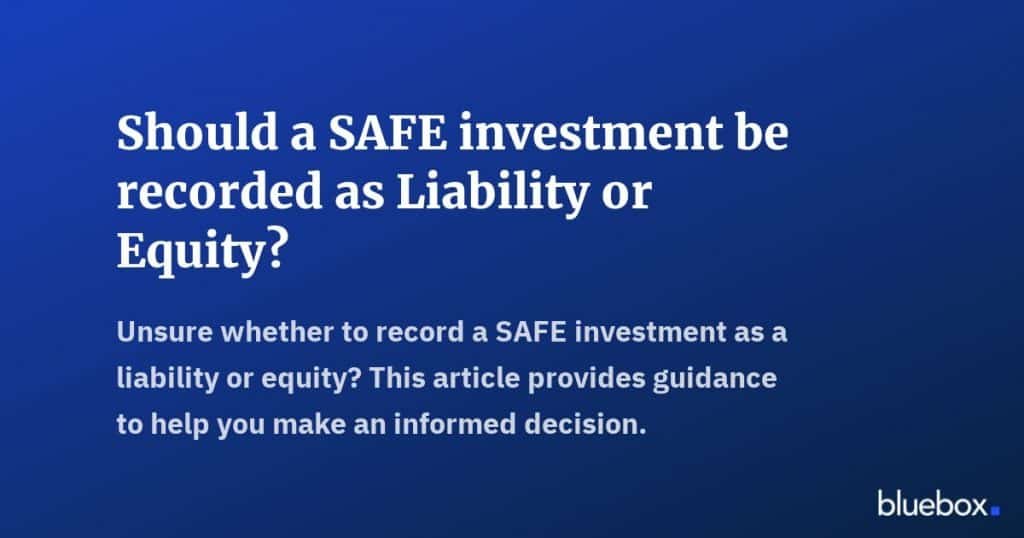SAFE investments, which stands for Simple Agreement for Future Equity, are financial instruments that are typically used by startups to raise funding.
Accounting Treatment of SAFE Investment for Startups
Startups that have raised funding via a SAFE may face confusion on how to record this investment on their balance sheet. The accounting treatment of SAFE investment is a topic of much debate in the startup world, with different opinions and approaches.
Record SAFE as Liability
While there is no definitive answer, one common approach is to record the SAFE investment as a liability on the balance sheet. This is because SAFEs represent a promise to issue equity in the future, rather than an immediate issuance of shares. Until the equity is issued, the company is obligated to the investor, and this obligation should be recorded as a liability.
SAFEs are Debt Instruments
Although SAFEs are not technically considered debt, they have similar characteristics. A SAFE investment represents the right to receive equity in the company at a future date, usually upon the occurrence of a triggering event such as a subsequent fundraising round or acquisition. Until that event occurs, the investor has no ownership or control over the company. This creates an obligation on the part of the company to deliver equity to the investor, similar to a debt instrument. Therefore, it is recorded as a liability on the balance sheet.
SAFEs Carry Risk and Uncertainty
Another reason why SAFEs are recorded as liabilities on the balance sheet is the uncertainty around their future conversion into equity. The terms of a SAFE agreement can vary widely and may include adjustments, valuation caps, and discounts that can impact the final conversion price. This uncertainty makes it difficult to determine the fair value of the SAFE investment and increases the risk for both the company and the investor. By recording SAFEs as liabilities, the company acknowledges this risk and provides transparency to its stakeholders.
Record SAFE as Equity
However, some argue that SAFE investment should be treated as equity, as it represents ownership in the company. This approach is mainly based on the fact that SAFEs are often used as a substitute for equity financing, and they give the investor some of the same rights and benefits as equity holders.
SAFEs are Similar to Equity
SAFEs are designed to be a simpler and more flexible alternative to equity financing. They offer investors the opportunity to invest in a company without committing to a specific valuation, and with the expectation of receiving equity at a later date. As such, recording SAFE investment as equity on the balance sheet makes sense, as it reflects the underlying expectation of the investors.
Equity Treatment Enhances Transparency
Recording SAFE investment as equity on the balance sheet enhances transparency and provides a clearer picture of a startup’s financial position. By treating SAFE investment as equity, startups can provide investors, stakeholders, and lenders with a more accurate representation of their financials, helping them make informed decisions about their investments and financing options.
Equity Treatment Supports Future Fundraising
When startups treat SAFE investment as equity on the balance sheet, they are demonstrating their commitment to building a strong financial foundation. This can help attract future investors, as it shows that the company is serious about building value for its shareholders. Additionally, treating SAFE investment as equity can also help startups negotiate better terms and valuations for future rounds of financing.
Why does it matter whether SAFE is Liability or Equity?
It is important to note that the accounting treatment of SAFE investment can have a significant impact on a company’s financial statements and ratios. For example, recording SAFE investment as equity can increase the company’s equity value and dilute the ownership of existing shareholders. On the other hand, recording it as a liability can increase the company’s debt-to-equity ratio and affect its creditworthiness.
Therefore, it is crucial for startups to consult with their accountants and legal advisors to determine the appropriate accounting treatment of SAFE investment based on their specific circumstances and goals. A clear understanding of the accounting implications of SAFEs can help startups make informed decisions and communicate effectively with investors and stakeholders.
